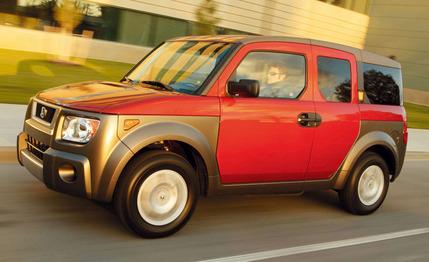 Road Test
Road Test
Have you ever wondered what would happen if an automaker morphed a Hummer H2 with a Mini Cooper?
We didn't think so. Not even our demented automotive minds cared to conjure up that image. But disregard that Conan O'Brien "If They Mated" photo, and the vehicle that would pop from the morph machine is actually pretty cool.
Think about it. It would have the exterior lines of the rough and tough Hummer, flavored with hints of the two-tone Mini, wrapped around the soul of a sports compact that's fun to drive yet could be taken off the beaten path. Plus, it would be relatively inexpensive and miserly at the fuel pump. A triple crossover.
Thankfully, the highly flexible minds at Honda have now built just such a vehicle. We say "thankfully" because it would take an automaker with one hell of an engineering pedigree to build a vehicle more versatile than a Hummer, sell it for less than a CR-V, and have the guts to affix an H badge to it.
That vehicle is the Element, the boxy sport-ute you see here. According to Honda, the Element's element is the 22-year-old single male who is hip, social, well-traveled, and loves extreme sports such as surfing and snowboarding - a demographic Honda has had difficulty luring. We're talking Generation Y's Mr. X Games here. These super-dudes are also well-educated, according to Honda, can afford a $17,000-to-$21,000 vehicle, and oh, yeah, they might not be gainfully employed. As this went to print, Honda was still ironing out details for the "Dude, I just graduated and I need some time to chill and play - relax, and send the bills to my folks" introductory lease program.
Although the Element is based on the CR-V, its dimensions are significantly different. The length is a foot shorter, the wheelbase has been trimmed 1.7 inches, the roofline is 7.8 inches higher, the front track 1.7 inches narrower, and the floor about an inch lower. It rides on a highly modified CR-V chassis, and because it has no visible B-pillars, it sports reinforced joints, strengthened lower side sills, larger crossmembers, enlarged rocker panels, and five bulkheads per side. In place of traditional B-pillars, Honda went with reinforced vertical beams within the rear doors and locked them into the side sills with a hook-and-catcher system. Honda claims the resulting chassis resists bending better than the CR-V, nearly matches it in twist resistance, and is strong enough to achieve a five-star side-impact rating.
The downside to the beefed-up structure is heft, and the front-wheel-drive, manual-transmission Element EX tested here tips the scales at 3344 pounds, just 23 pounds shy of a four-wheel-drive, manual-transmission CR-V EX we tested in November 2001. Honda says Elements haul an extra 250 pounds compared with similarly equipped CR-Vs. To compensate for the added weight, Honda shortened the gearing, increased roll stiffness, and upped the damping levels of the suspension.